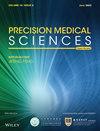Risk factors of dermatitis during radiation for vulvar carcinoma
IF 0.6
Q4 MEDICINE, RESEARCH & EXPERIMENTAL
引用次数: 0
Abstract
Radiodermatitis, inflammatory lesions of skin and mucosa caused by radiation, is a common adverse effect during the radiation therapy of vulvar carcinoma. The incidence of radiodermatitis is affected by various factors, and the purpose of this study was to investigate the risk factors of radiodermatitis in patients with vulvar carcinoma. Patients with vulvar tumors who received radiotherapy from January 2015 to December 2020 were included in this retrospective study. Radiodermatitis was graded according to the grading criteria of the American Center for Radiological Oncology, and then univariate analysis and logistic multivariate regression analysis were used to determine the risk factors of radiodermatitis. A total of 60 eligible patients were enrolled, including 3 (5%), 25 (41.7%), 28 (46.7%), and 4 (6.6%) patients with grade 0, 1, 2, and 3 radiodermatitis, respectively. Univariate analysis showed that the incidence of radiodermatitis was significantly correlated with age, therapeutic strategy, pathological stage and radiotherapy dose (p < .05). Multivariate regression analysis indicated that age, therapeutic strategy and radiotherapy dose were independent risk factors for radiodermatitis (p < .05). In the current study, we identified the independent risk factors for radiodermatitis in patients with vulvar carcinoma were age, therapeutic strategy and radiotherapy dose, which might be conducive to identify high‐risk patients, so as to adjust their treatment plan in time and reduce the risk of radiation‐induced skin toxicity.外阴癌放疗期间皮炎的危险因素
放射性皮炎是由辐射引起的皮肤和粘膜炎症性病变,是外阴癌放射治疗中常见的不良反应。放射性皮炎的发病率受多种因素的影响,本研究旨在探讨外阴癌患者发生放射性皮炎的危险因素。本回顾性研究纳入了2015年1月至2020年12月接受放疗的外阴肿瘤患者。根据美国放射肿瘤中心的分级标准对放射性皮炎进行分级,然后使用单变量分析和逻辑多变量回归分析来确定放射性皮炎的危险因素。共有60名符合条件的患者入选,其中分别有3名(5%)、25名(41.7%)、28名(46.7%)和4名(6.6%)放射性皮炎0级、1级、2级和3级患者。单因素分析表明,放射性皮炎的发生率与年龄、治疗策略、病理分期和放疗剂量显著相关(p < .05)。多元回归分析表明,年龄、治疗策略和放疗剂量是放射性皮炎的独立危险因素(p < .05)。在目前的研究中,我们确定了外阴癌患者放射性皮炎的独立危险因素是年龄、治疗策略和放疗剂量,这可能有助于识别高危患者,从而及时调整他们的治疗计划,降低辐射诱发皮肤毒性的风险。
本文章由计算机程序翻译,如有差异,请以英文原文为准。
求助全文
约1分钟内获得全文
求助全文

 求助内容:
求助内容: 应助结果提醒方式:
应助结果提醒方式:


